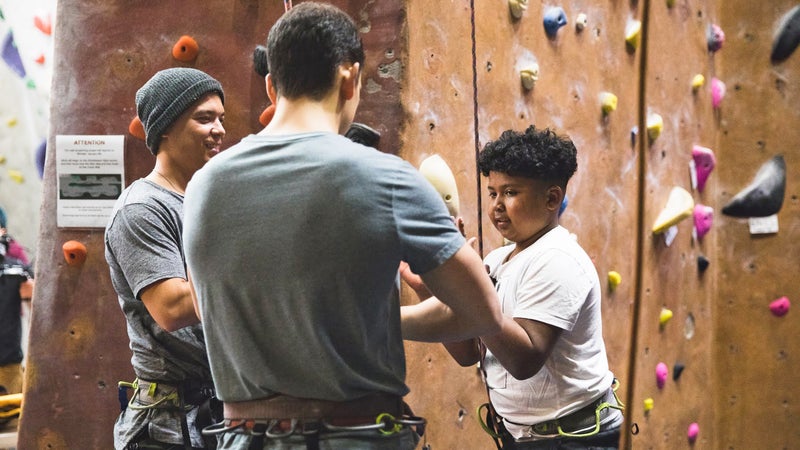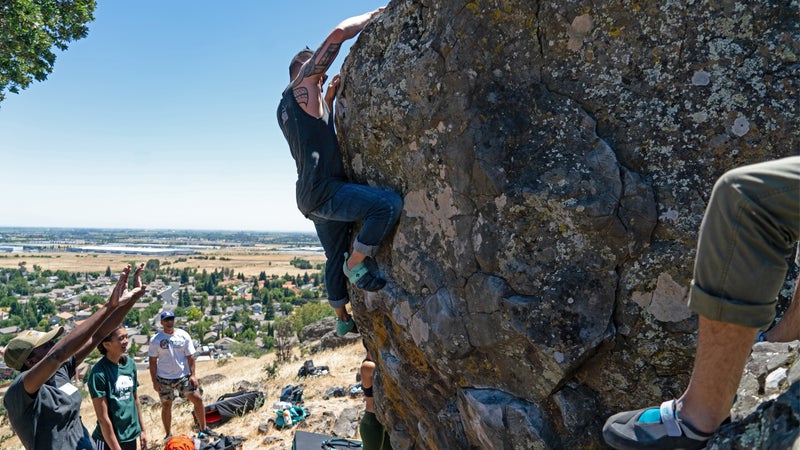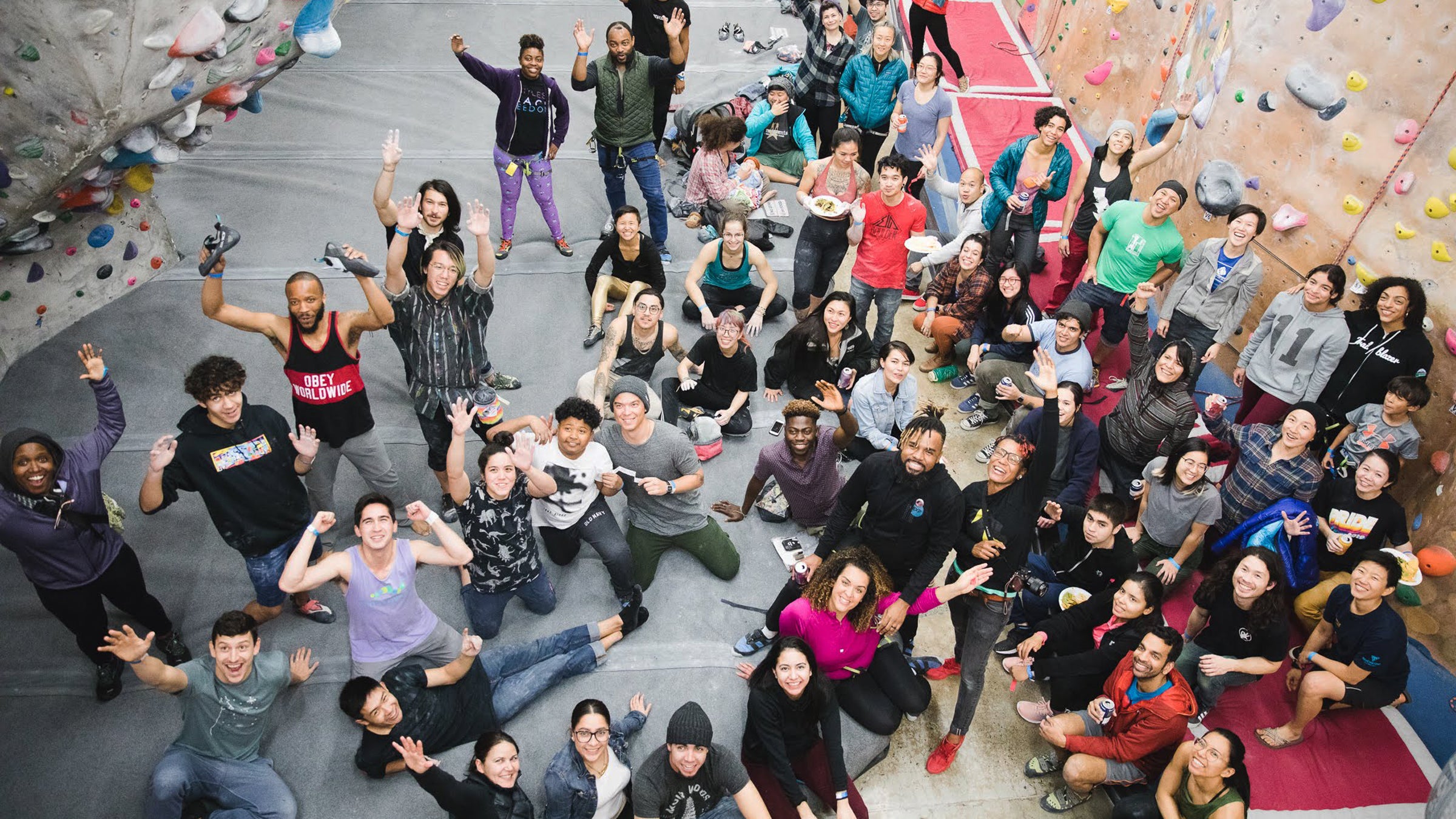On a Wednesday evening earlier this year��at , a San Francisco climbing gym, James Dong and Max Morales stood at a table by the front door to greet arriving climbers. Each newcomer was offered a blue and yellow sticker adorned with a geometric logo and the words “The Brown Ascenders.” By 7 P.M., a circle of black and brown climbers had assembled in one��corner.
“Raise your hand if you’ve been to a Brown Ascenders meetup before,” Morales said. About a dozen hands went up. Some people were there to try rock��climbing for the first time. Others had been attending for years, since the group first formed to create a��community for��climbers who are black, indigenous, and other people of color (BIPOC).
The Brown Ascenders, which formed in 2017 and registered as a nonprofit in 2019, is one of many groups across the country bringing climbers of color together. (Additional��organizations include ��and ,��both working��to increase representation and inclusion in the sport��and collaborating��to host the popular each year.) The movement is not unique to rock climbing: the groups and , for example, focus on increasing the visibility of BIPOC individuals in other outdoor recreation spaces. The Brown Ascenders is pushing the movement one step further. With its��new nonprofit status, the organization is taking��on bigger projects��and trying to��make it easier for climbers everywhere to feel at home in their local gym or at their local crag.
The Brown Ascenders began when Summer Winston, a professor at Santa Rosa Junior College, in California,��attended Color the Crag in 2017. Winston (who prefers��they/their pronouns when being referred to) had��been climbing for a couple of years before the festival��but had never come across��a climbing community that consisted��mostly of people of color. “I never knew I needed that space,” Winston says. “The energy was amazing. At the end of that first festival, we were leaving, and��I said, ‘I want to bring this back to the Bay.’”
Winston returned home from the climbing festival on a Sunday. By Tuesday, they had a name, a logo, and an Instagram page��for what would become the Brown Ascenders. They soon met with a local gym to negotiate a special deal for members: climbers got free day passes for Brown Ascenders meetups, and gyms waived their initiation fees. Climbing is an expensive sport, Winston points out, so removing some of the cost can give people a reason to try something new.
Since then, Winston and the group have��hosted more than 40 meetups in five cities and two states. And they’ve brought on community organizers, like Morales and Dong, to plan the meetups for their home gyms.

On the crowded floor of Dogpatch Boulders, the��Brown Ascenders were having a blast, with climbers working the same boulders and cheering each other on.
Aubrie Johnson, 30, watched quizzically as four of her friends collapsed on the crash pads, giggling. Johnson has lived in San Francisco’s Potrero Hill neighborhood—not far from Dogpatch—for more than 15 years. She has been climbing since 2016��but says she would have quit if she hadn’t found the climbing community the Brown Ascenders offers. The gym reflects��the gentrifying population of the city, she says,��and previously, she found it hard to meet people she clicked with.
Abioula Akanni, 26, recently moved to the Bay Area from New Orleans. He met Winston at Color the Crag��and has��helped organize the Dogpatch meetups ever since. “This is my jam,”��Akanni says. “It’s something I care about. It’s about getting black and brown people together to climb and build community. Summer had a great vision.”
Winston says��communities like the Brown Ascenders make it easier for people to try the sport��and stick with it. When��Winston��started climbing in a gym in Texas, they say��it took more than six months before they saw another black person in the gym. “It felt good to see someone else walk in that space that looked like me,” Winston says. “I feel like that happens a lot to other folks, that’s not a unique story.”
While BIPOC climbers often deal with both large and small racist incidents in climbing gyms, Winston notes that even if people aren’t being explicitly racist at such a place, it can be uncomfortable if you’re the only nonwhite person in the room.
Winston wants people to understand the importance of comfort and a sense of belonging in outdoor recreational activities. “If it feels uncomfortable to go into that space, there’s no incentive,” Winston says. Having a supportive climbing community, they believe,��“makes the difference between people coming back and never trying it again.”

In the summer of 2019, after the Brown Ascenders had hosted climbing hangouts for a year and a half, Winston started��thinking about expanding the group’s work. It felt great to be bonding at the climbing gym, but Winston wasn’t convinced they were creating lasting change. So in��November, the Brown Ascenders became a nonprofit��and began planning to take on a wider range of projects. Winston has a long list of ideas about the future, including equity and inclusion training for gyms, kid’s camps, and outdoor clinics. But they are also rooting the new programming in data and community feedback. They plan to conduct a research project in gyms across the Bay Area in 2020 (which has been postponed due to COVID-19) that asks climbers of all colors what an inclusive space would look like to them.
“I can go to a gym as one person and say, ‘Hey, like, these are ideas I have for things that you can do to make this space more accessible.’ But I’m one person,” Winston says. “If I go with 4,000 survey results and say, ‘Hey, this is what 4,000 members of our community are asking for,’ it gives me, like, a foot to stand on.”
Since starting the Brown Ascenders, Winston has experienced moments of doubt. They’ve been accused, mostly by white climbers, of causing divides in the climbing world. And even before the Brown Ascenders launched, some BIPOC climbers were skeptical that organizing a group was necessary, telling Winston they thought the Bay Area climbing scene was in much better shape than other parts of the country.
“Sometimes I get in my head, and I’m like, Are we really doing something good? Is this really important?’’ Winston says.
But participants’ enthusiasm at the meetups always reminds Winston��that��the group is changing the game��by creating a welcoming��experience in an outdoor sport where people of color still can’t always take those things for granted.
“At the end of the night, people say,��‘This was so amazing. It felt so good and fun to just be here and, like, feel encouraged by everyone,’” Winston says. “People will leave me��little notes just saying, ‘Thank you for hosting this.’ That means the world to me.”


